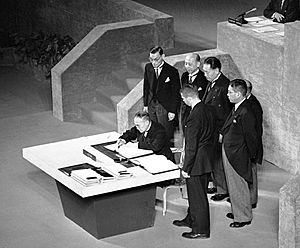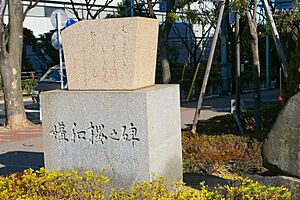Treaty of San Francisco facts for kids
| Treaty of Peace with Japan | |
|---|---|

Shigeru Yoshida, Prime Minister of Japan signing the San Francisco Peace Treaty on September 8, 1951 at the War Memorial Opera House in San Francisco, California
|
|
| Signed | 8 September 1951 |
| Location | San Francisco, California, U.S. |
| Effective | 28 April 1952 |
| Negotiators | |
| Parties | |
| Languages | |
The Treaty of San Francisco, also known as the Treaty of Peace with Japan, was a very important agreement. It officially ended the state of war between Japan and many other countries (called the Allied Powers) after World War II.
This treaty was signed by 49 nations on September 8, 1951, in San Francisco, California, USA. It became active on April 28, 1952. This meant the US-led Allied occupation of Japan officially ended. Japan became a fully independent country again.
The treaty also made sure that Japan accepted the decisions of the war crimes courts. It helped Japan pay back countries and people who suffered during the war. This treaty, along with another agreement signed the same day, shaped Japan's relationship with the United States and its role in the world after the war.
Contents
Who Attended the Conference?
Many countries attended the conference in San Francisco to sign the treaty. These included Argentina, Australia, Belgium, Brazil, Canada, Ceylon (now Sri Lanka), Chile, Colombia, Cuba, Egypt, France, Greece, India, Indonesia, Japan, Mexico, the Netherlands, New Zealand, Norway, Pakistan, the Philippines, Saudi Arabia, South Africa, the United Kingdom, the United States, and Vietnam.
Some countries were not invited or chose not to come.
- China was not invited because countries could not agree on which Chinese government was the real one.
- Korea was also not invited for similar reasons.
- India and Yugoslavia were invited but decided not to participate. India signed its own peace treaty with Japan later.
- Italy was not invited, even though it had declared war on Japan.
Different Views on the Treaty
Not everyone agreed on the treaty's terms.
The Soviet Union's Objections
The Soviet Union was at the conference but strongly disagreed with the treaty. Their representative, Andrei Gromyko, said the treaty:
- Did not stop Japanese militarism (the idea of a strong military).
- Did not include China, a main victim of Japan's actions.
- Made Japan an American military base against the Soviet Union.
- Did not recognize the Soviet Union's control over certain islands.
The Soviet Union and Japan did not officially end their war until 1956.
Sri Lanka Defends Japan
A country called Ceylon (now Sri Lanka) played a big part in supporting Japan. Many countries wanted to punish Japan harshly. But Ceylon's Finance Minister, J.R. Jayawardene, spoke up for Japan.
He said that Ceylon would not ask for money from Japan. He believed that "hatred ceases not by hatred but by love." He wanted Japan to be free and to join the world in peace and success. His speech was very well received.
Who Signed and Approved the Treaty?
Out of the 51 countries that attended, 48 signed the treaty. Czechoslovakia, Poland, and the Soviet Union refused to sign.
The countries that signed included Japan and many Allied nations like the United States, United Kingdom, Australia, Canada, and the Philippines.
- The Philippines approved the treaty in 1956 after signing a separate agreement with Japan about payments.
- Indonesia did not approve this treaty. Instead, it signed its own agreement with Japan in 1958.
- A separate treaty, the Treaty of Taipei, was signed between Japan and the Republic of China on April 28, 1952. This happened just hours before the San Francisco Treaty became active.
What Happened to Japan's Former Territories?
The treaty made Japan give up its rights to many places it had controlled. These included:
- Korea
- Taiwan and the Pescadores Islands
- Hong Kong
- The Kuril Islands
- The Spratly Islands
- South Sakhalin
The treaty also suggested that the Bonin Islands and Ryukyu Islands (which include Okinawa) could become a special area under the United Nations. However, this did not happen. These islands were later returned to Japan in stages. The Bonin Islands were returned in 1968, and the Ryukyu Islands (including Okinawa) in 1972.
There is still some debate about who owns certain islands, like the Senkaku Islands and the Kuril Islands, because the treaty's wording was not perfectly clear.
Payments to Countries and Prisoners of War
Japanese Assets Overseas
The treaty said that Allied countries could take over Japanese government and company assets in places Japan had occupied. For example, China took over Japanese mines and railways in Manchuria.
Here is a table showing the value of Japanese assets in different regions in 1945:
| Country/region | Value (Yen) | Value (US Dollars) |
|---|---|---|
| Korea | 70,256,000,000 | 4,683,700,000 |
| Taiwan and Penghu | 42,542,000,000 | 2,846,100,000 |
| North East China | 146,532,000,000 | 9,768,800,000 |
| North China | 55,437,000,000 | 3,695,800,000 |
| Central South China | 36,718,000,000 | 2,447,900,000 |
| Others | 28,014,000,000 | 1,867,600,000 |
| Total | ¥379,499,000,000 | $25,300,000,000 |
Help for Former Prisoners of War (POWs)
The treaty also said that Japan would give money to the Red Cross. This money was meant to help former prisoners of war (POWs) and their families who suffered during the war. Japan paid about £4.5 million for this purpose.
This part of the treaty has prevented later lawsuits by former Allied POWs against Japan.
Compensation to Occupied Countries
The treaty recognized that Japan should pay for the damage it caused during the war. However, it also understood that Japan's economy was not strong enough to pay everything at once.
So, Japan agreed to negotiate with countries that its forces had occupied. Japan would help these countries by providing services, like people working in production or salvaging.
- The Philippines and Vietnam received payments from Japan in the 1950s.
- Burma and Indonesia also signed agreements with Japan later to receive compensation.
Here is a table of payments made to countries occupied by Japan:
| Country | Amount in Yen | Amount in US$ | Date of treaty |
|---|---|---|---|
| Burma | 72,000,000,000 | 200,000,000 | November 5, 1955 |
| Philippines | 198,000,000,000 | 550,000,000 | May 9, 1956 |
| Indonesia | 80,388,000,000 | 223,080,000 | January 20, 1958 |
| Vietnam | 14,400,000,000 | 38,000,000 | May 13, 1959 |
| Total | ¥364,348,800,000 | US$1,012,080,000 | N/A |
The last payment was made to the Philippines in 1976.
China later gave up its right to ask for war payments from Japan in 1972, to improve friendship between the two countries.
Unresolved Issues
Some parts of the treaty are still discussed today.
Taiwan's Status
The treaty stated that Japan gave up its claim to Taiwan. However, it did not clearly say who Taiwan belonged to after that. This has led to different ideas about Taiwan's future. Some people believe Taiwan's status is still undecided.
Compensation for Korea
Because Korea did not sign the San Francisco Treaty, it did not directly receive payments under it. When Japan and South Korea normalized their relations in 1965, Japan agreed to pay money to the South Korean government. The Korean government was then supposed to compensate individuals who suffered. However, much of this money was used for Korea's economic development, and not all victims received direct payments. This is still a sensitive issue between the two countries.
See also
 In Spanish: Tratado de San Francisco para niños
In Spanish: Tratado de San Francisco para niños


